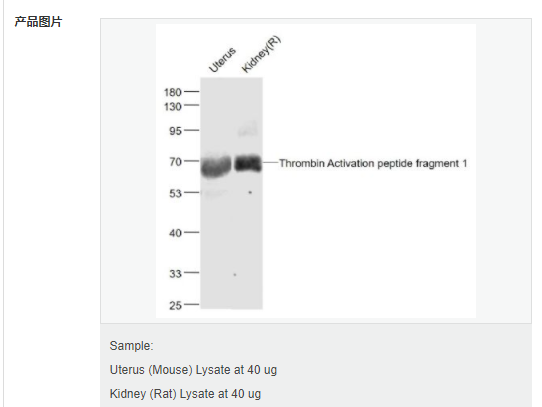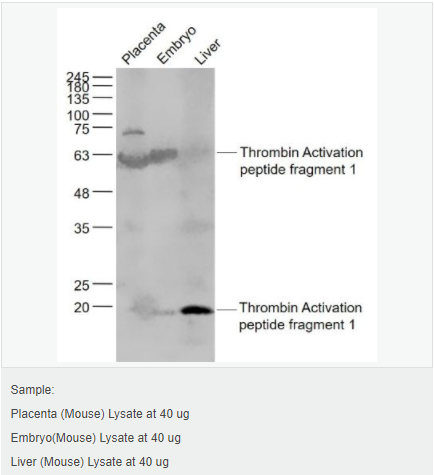

貨號
產品規格
售價
備注
BN40248R-100ul
100ul
¥2360.00
交叉反應:Mouse,Rat(predicted:Human,GuineaPig) 推薦應用:WB,IHC-P,IHC-F,IF,ELISA
BN40248R-200ul
200ul
¥3490.00
交叉反應:Mouse,Rat(predicted:Human,GuineaPig) 推薦應用:WB,IHC-P,IHC-F,IF,ELISA
產品描述
| 英文名稱 | Thrombin Activation peptide fragment 1 |
| 中文名稱 | 凝血酶(凝血因子II)激活肽1抗體 |
| 別 名 | Activation peptide fragment 1; coagulation factor II; prothrombin; F2; Cf-2; Cf2; FII; F 2; coagulation factor II (thrombin); Coagulation factor II; Coagulation factor II precursor; F2; Factor II; Factor-II; Prothrombin; prothrombin B-chain; PT; serine protease; THRB; THRB_HUMAN; Thrombin. |
| 研究領域 | 心血管 細胞生物 激酶和磷酸酶 合成與降解 |
| 抗體來源 | Rabbit |
| 克隆類型 | Polyclonal |
| 交叉反應 | Mouse, Rat, (predicted: Human, Guinea Pig, ) |
| 產品應用 | WB=1:500-2000 ELISA=1:5000-10000 IHC-P=1:100-500 IHC-F=1:100-500 IF=1:100-500 (石蠟切片需做抗原修復) not yet tested in other applications. optimal dilutions/concentrations should be determined by the end user. |
| 分 子 量 | 17/64kDa |
| 細胞定位 | 細胞外基質 分泌型蛋白 |
| 性 狀 | Liquid |
| 濃 度 | 1mg/ml |
| 免 疫 原 | KLH conjugated synthetic peptide derived from human Thrombin Activation peptide fragment 1:51-150/622 |
| 亞 型 | IgG |
| 純化方法 | affinity purified by Protein A |
| 儲 存 液 | 0.01M TBS(pH7.4) with 1% BSA, 0.03% Proclin300 and 50% Glycerol. |
| 保存條件 | Shipped at 4℃. Store at -20 °C for one year. Avoid repeated freeze/thaw cycles. |
| PubMed | PubMed |
| 產品介紹 | Thrombin is the final protease in the blood coagulation cascade and serves both pro- and anticoagulant functions through the cleavage of several targets. The ability of thrombin to specifically recognize a wide range of substrates derives from interactions which occur outside of the active site of thrombin. Thrombin possesses two anion binding exosites which mediate many of its interactions with cofactors and substrates, and although many structures of thrombin have been solved, few such interactions have been described in molecular detail. Glycosaminoglycan binding to exosite II of thrombin plays a major role in switching off the procoagulant functions of thrombin by mediating its irreversible inhibition by circulating serpins and by its binding to the endothelial cell surface receptor thrombomodulin. Function: Thrombin is an active enzyme in the earliest steps of the blood clot formation, generated from its circulating inactive precursor prothrombin. Thrombin is a glycoprotein formed by two peptides chains of 36 and 259 amino acids linked by disulfure bonds. Three important sites have been identified on the surface of the enzyme: The catalytic site that confers to the molecule its serine protease activity, the exosite one responsible for the binding of the substrate (fibrinogen or thrombin receptor) and the exosite two responsible for the binding of antithrombin III and inactivation of thrombin. Gamma Thrombin is a proteolyzed form of Alpha Thrombin. Gamma Thrombin consists of four chains (A, B1, B5, B4) with a disulfide link between the A peptide and the B5 peptide. Subunit: Heterodimer (named alpha-thrombin) of a light and a heavy chain; disulfide-linked. Forms a heterodimer with SERPINA5. Subcellular Location: Secreted, extracellular space. Tissue Specificity: Expressed by the liver and secreted in plasma. Post-translational modifications: The gamma-carboxyglutamyl residues, which bind calcium ions, result from the carboxylation of glutamyl residues by a microsomal enzyme, the vitamin K-dependent carboxylase. The modified residues are necessary for the calcium-dependent interaction with a negatively charged phospholipid surface, which is essential for the conversion of prothrombin to thrombin. N-glycosylated. N-glycan heterogeneity at Asn-121: Hex3HexNAc3 (minor), Hex4HexNAc3 (minor) and Hex5HexNAc4 (major). At Asn-143: Hex4HexNAc3 (minor) and Hex5HexNAc4 (major). DISEASE: Factor II deficiency (FA2D) [MIM:613679]: A very rare blood coagulation disorder characterized by mucocutaneous bleeding symptoms. The severity of the bleeding manifestations correlates with blood factor II levels. Note=The disease is caused by mutations affecting the gene represented in this entry. Ischemic stroke (ISCHSTR) [MIM:601367]: A stroke is an acute neurologic event leading to death of neural tissue of the brain and resulting in loss of motor, sensory and/or cognitive function. Ischemic strokes, resulting from vascular occlusion, is considered to be a highly complex disease consisting of a group of heterogeneous disorders with multiple genetic and environmental risk factors. Note=Disease susceptibility is associated with variations affecting the gene represented in this entry. Thrombophilia due to thrombin defect (THPH1) [MIM:188050]: A multifactorial disorder of hemostasis characterized by abnormal platelet aggregation in response to various agents and recurrent thrombi formation. Note=The disease is caused by mutations affecting the gene represented in this entry. A common genetic variation in the 3-prime untranslated region of the prothrombin gene is associated with elevated plasma prothrombin levels and an increased risk of venous thrombosis. Pregnancy loss, recurrent, 2 (RPRGL2) [MIM:614390]: A common complication of pregnancy, resulting in spontaneous abortion before the fetus has reached viability. The term includes all miscarriages from the time of conception until 24 weeks of gestation. Recurrent pregnancy loss is defined as 3 or more consecutive spontaneous abortions. Note=Disease susceptibility is associated with variations affecting the gene represented in this entry. Similarity: Belongs to the peptidase S1 family. Contains 1 Gla (gamma-carboxy-glutamate) domain. Contains 2 kringle domains. Contains 1 peptidase S1 domain. SWISS: P00734 Gene ID: 2147 Database links: Entrez Gene: 2147 Human Omim: 176930 Human SwissProt: P00734 Human Unigene: 655207 Human Important Note: This product as supplied is intended for research use only, not for use in human, therapeutic or diagnostic applications. |

